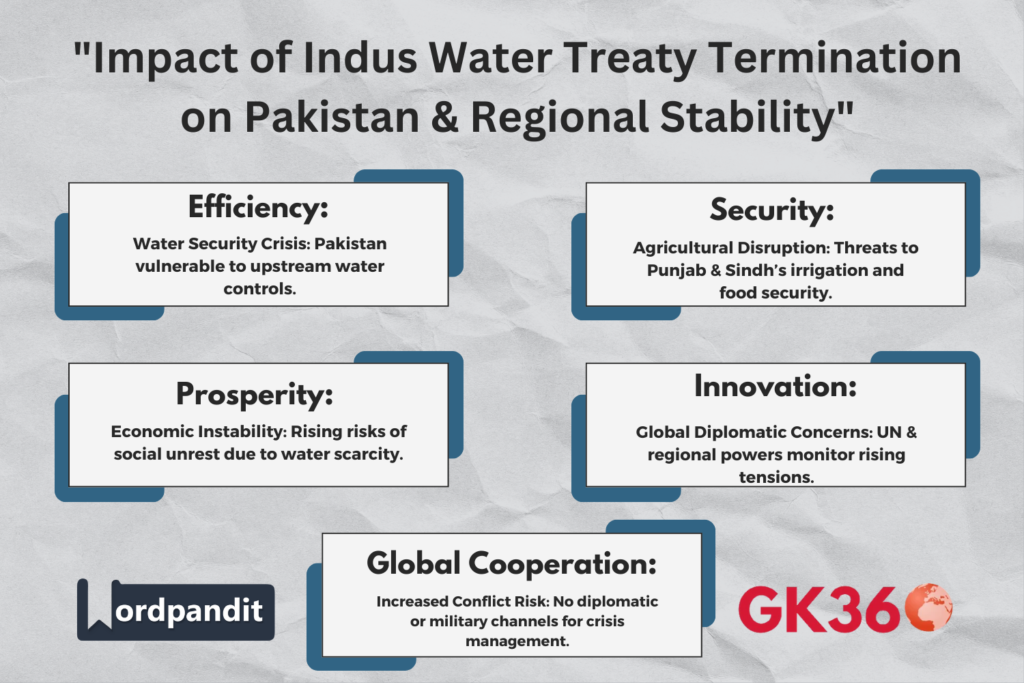India Ends Indus Water Treaty 2025: Impact on Pakistan, Water Security & Regional Stability
In a historic and unprecedented move, India has officially terminated the Indus Water Treaty (IWT) in 2025, marking a dramatic escalation in its long-tense relationship with Pakistan. Alongside this bold decision, India has sealed the Atari-Wagah border, suspended visa services for Pakistani citizens, and withdrawn all defence advisors—effectively freezing diplomatic, civilian, and military ties.
This decisive shift in India’s foreign policy towards Pakistan signals a new era of assertiveness, where national security and sovereignty take precedence over legacy agreements and traditional diplomacy. As the world watches closely, questions loom over the future of South Asian stability, Pakistan’s water security, and the broader implications for international water-sharing agreements.

Table of Contents
- Overview: What is the Indus Water Treaty?
- Why India Terminated the Indus Water Treaty in 2025
- India-Pakistan Border Closure & Visa Suspension: What It Means
- End of Defence Diplomacy: No More Military Dialogue
- Key Impacts of India’s Withdrawal
- FAQs: India-Pakistan Indus Water Treaty Crisis
- Conclusion: The Future of India-Pakistan Relations Post-Treaty
Overview: What is the Indus Water Treaty?
Signed in 1960 under the mediation of the World Bank, the Indus Water Treaty (IWT) was a landmark water-sharing agreement between India and Pakistan. It allocated control of:
- Eastern Rivers (Ravi, Beas, Sutlej) to India.
- Western Rivers (Indus, Jhelum, Chenab) to Pakistan.
For over six decades, despite wars and persistent hostilities, the IWT stood as a rare beacon of cooperation—providing structured mechanisms for data sharing, dispute resolution, and sustainable river management. Globally recognized, the treaty was often cited as a model for transboundary water diplomacy.
With its termination, a critical framework for peaceful water-sharing in South Asia has collapsed, ushering in a period of uncertainty and heightened geopolitical risk.
Why India Terminated the Indus Water Treaty in 2025
India’s decision to end the IWT stems from years of deteriorating bilateral relations. Escalating issues such as:
- Cross-border terrorism,
- Infiltration attempts, and
- Diplomatic standoffs
…have eroded trust and rendered traditional diplomatic frameworks ineffective.
By withdrawing from the treaty, India is asserting its hydro-sovereignty, signaling that it will no longer honor agreements perceived as detrimental under current adversarial conditions. This move aligns with India’s strategic recalibration—favoring firm geopolitical messaging over outdated engagement protocols.
Moreover, it reflects India’s intent to fully harness its water resources, particularly in sensitive regions like Jammu & Kashmir and Ladakh, without treaty-imposed limitations.
India-Pakistan Border Closure & Visa Suspension: What It Means
In a parallel measure, India has sealed the Atari-Wagah border—the primary land link between the two nations—halting all civilian travel and trade. The suspension of visa services for Pakistani nationals further deepens the divide, effectively cutting off avenues for:
- Cultural exchanges,
- Limited commercial activities, and
- People-to-people diplomacy.
These actions demonstrate India’s pivot towards coercive diplomacy through non-military means. By freezing civilian interaction, India is leveraging economic and social pressure while avoiding direct military conflict—an approach aimed at compelling Pakistan to reassess its provocations and policies.
End of Defence Diplomacy: No More Military Dialogue
Perhaps the most telling indicator of this hardened stance is India’s decision to expel Pakistani Defence, Naval, and Air Force advisors, while recalling its own from Islamabad. Traditionally, these channels served as crucial backdoors for:
- Ceasefire negotiations,
- Crisis de-escalation, and
- Military transparency.
By shutting down this last formal communication link, India has signaled that defence diplomacy is no longer viable in the face of persistent hostility. This marks a definitive end to structured military dialogue, raising the stakes for future border incidents and security flashpoints.
Key Impacts of India’s Withdrawal
India’s Control Over Indus Waters
By terminating the IWT, India gains full autonomy over the eastern and western rivers within its territory. This opens doors for:
- Accelerated construction of dams, hydroelectric plants, and water diversion projects.
- Enhanced water resource management in regions like Jammu & Kashmir and Ladakh.
- Strategic use of water as a geopolitical tool.
This move aligns with India’s long-term vision of maximizing its natural resources without external constraints, reinforcing national sovereignty over critical infrastructure.
Pakistan’s Growing Water Crisis
For Pakistan, the fallout is immediate and severe. The western rivers—vital for irrigation and drinking water—are now vulnerable to potential upstream interventions by India. Key concerns include:
- Disruption to agriculture in Punjab and Sindh.
- Threats to food security and rural livelihoods.
- Increased risk of economic instability and social unrest due to water scarcity.
Without treaty protections, Pakistan faces a looming water insecurity crisis, amplifying its existing environmental and economic challenges.
Why India Terminated the Indus Water Treaty in 2025
India’s decision to end the IWT stems from years of deteriorating bilateral relations. Escalating issues such as:
- Cross-border terrorism,
- Infiltration attempts, and
- Diplomatic standoffs
…have eroded trust and rendered traditional diplomatic frameworks ineffective.
By withdrawing from the treaty, India is asserting its hydro-sovereignty, signaling that it will no longer honor agreements perceived as detrimental under current adversarial conditions. This move aligns with India’s strategic recalibration—favoring firm geopolitical messaging over outdated engagement protocols.
Moreover, it reflects India’s intent to fully harness its water resources, particularly in sensitive regions like Jammu & Kashmir and Ladakh, without treaty-imposed limitations.
India-Pakistan Border Closure & Visa Suspension: What It Means
In a parallel measure, India has sealed the Atari-Wagah border—the primary land link between the two nations—halting all civilian travel and trade. The suspension of visa services for Pakistani nationals further deepens the divide, effectively cutting off avenues for:
- Cultural exchanges,
- Limited commercial activities, and
- People-to-people diplomacy.
These actions demonstrate India’s pivot towards coercive diplomacy through non-military means. By freezing civilian interaction, India is leveraging economic and social pressure while avoiding direct military conflict—an approach aimed at compelling Pakistan to reassess its provocations and policies.
End of Defence Diplomacy: No More Military Dialogue
Perhaps the most telling indicator of this hardened stance is India’s decision to expel Pakistani Defence, Naval, and Air Force advisors, while recalling its own from Islamabad. Traditionally, these channels served as crucial backdoors for:
- Ceasefire negotiations,
- Crisis de-escalation, and
- Military transparency.
By shutting down this last formal communication link, India has signaled that defence diplomacy is no longer viable in the face of persistent hostility. This marks a definitive end to structured military dialogue, raising the stakes for future border incidents and security flashpoints.
Key Impacts of India’s Withdrawal
India’s Control Over Indus Waters
By terminating the IWT, India gains full autonomy over the eastern and western rivers within its territory. This opens doors for:
- Accelerated construction of dams, hydroelectric plants, and water diversion projects.
- Enhanced water resource management in regions like Jammu & Kashmir and Ladakh.
- Strategic use of water as a geopolitical tool.
This move aligns with India’s long-term vision of maximizing its natural resources without external constraints, reinforcing national sovereignty over critical infrastructure.
Pakistan’s Growing Water Crisis
For Pakistan, the fallout is immediate and severe. The western rivers—vital for irrigation and drinking water—are now vulnerable to potential upstream interventions by India. Key concerns include:
- Disruption to agriculture in Punjab and Sindh.
- Threats to food security and rural livelihoods.
- Increased risk of economic instability and social unrest due to water scarcity.
Without treaty protections, Pakistan faces a looming water insecurity crisis, amplifying its existing environmental and economic challenges.
Global Reactions to the Treaty Termination
The abrogation of a World Bank-brokered international treaty has drawn global attention. Likely responses include:
- Diplomatic interventions by bodies like the United Nations.
- Concern from regional powers such as China, which shares complex border and water dynamics with both nations.
- Increased focus on creating new frameworks for transboundary water governance in South Asia.
This development could set a precedent impacting other global water-sharing agreements, making it a pivotal case study in international diplomacy.
Rising Risks to South Asian Peace
With diplomatic, civilian, and military communication channels severed, the margin for error has drastically reduced. Potential risks include:
- Border skirmishes escalating due to lack of crisis management frameworks.
- Increased militarization along sensitive zones.
- A destabilized South Asia, with ripple effects on global trade routes and security alliances.
The absence of dialogue mechanisms heightens the probability of misunderstandings turning into conflicts, threatening regional stability.

FAQs: India-Pakistan Indus Water Treaty Crisis
- What was the Indus Water Treaty and why was it important?
The IWT, signed in 1960, was a water-sharing agreement between India and Pakistan ensuring cooperative management of the Indus river system. It stood as a rare symbol of peaceful engagement despite decades of hostility. - Why did India terminate the Indus Water Treaty in 2025?
India ended the treaty due to escalating security threats, cross-border terrorism, and a strategic shift prioritizing sovereignty over outdated diplomatic frameworks. - How will Pakistan be affected by the termination of the IWT?
Pakistan faces significant risks to its water security, especially in agricultural regions reliant on the Indus, Jhelum, and Chenab rivers. This could lead to economic and social instability. - What are the global implications of this move?
The termination raises concerns about international treaty reliability, regional security in South Asia, and sets a precedent for handling transboundary water disputes worldwide. - Is there a possibility of renewed dialogue between India and Pakistan?
While current relations are frozen, future dialogue may depend on shifts in geopolitical dynamics, third-party mediation, or changes in leadership approaches on both sides.
Conclusion: The Future of India-Pakistan Relations Post-Treaty
India’s bold decision to terminate the Indus Water Treaty, close its borders, suspend visas, and end defence diplomacy marks a defining moment in South Asian geopolitics. This strategic pivot emphasizes India’s commitment to safeguarding its national interests through assertive policies.
However, this recalibration comes with heightened risks—particularly concerning regional stability, water security, and potential humanitarian impacts. The global community will be watching closely to see if this era of disengagement can eventually give way to new diplomatic frameworks or if it signals prolonged tension.
Key Takeaways Table
| Aspect | Details |
| Indus Water Treaty (IWT) | 1960 water-sharing pact between India & Pakistan mediated by World Bank. |
| Reason for Termination | Escalation of cross-border terrorism, diplomatic standoffs, and sovereignty assertion. |
| India’s Strategic Actions | Border closure, visa suspension, expulsion of defence advisors. |
| Pakistan’s Challenges | Looming water crisis, agricultural disruption, and economic instability. |
| Global Response | Diplomatic concerns from UN, China, and focus on new water governance models. |
| Regional Stability Risks | Increased chances of conflict due to severed communication channels. |
| Future Outlook | Uncertain prospects for renewed dialogue; heightened geopolitical tensions. |





